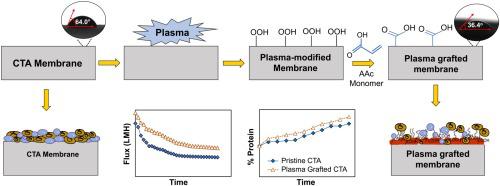Journal of Water Process Engineering ( IF 6.3 ) Pub Date : 2020-09-19 , DOI: 10.1016/j.jwpe.2020.101633 Watsa Khongnakorn , Weerapong Bootluck , Panitan Jutaporn

|
The aim of this study was to compared the effect of two plasma gases, Argon (Ar) and carbon dioxide (CO2), in the acrylic acid (AAc) grafting modification of a commercial cellulose triacetate (CTA) membrane to improve water flux and anti-protein fouling properties in forward osmosis (FO) for protein recovery application. The successful grafting polymerization was evaluated by measuring the grafting yield and water contact angle, X-ray photoelectron spectroscopy (XPS) analysis, Attenuated Total Reflectance-Fourier Transform Infrared spectroscopy (ATR-FTIR) analysis. The contact angle of the CTA membrane was decreased from 64.0° to 37.1° and 36.4° by CO2 and Ar plasma gas treatment, respectively, which indicated an increase in hydrophilicity. The FO experiments were carried out in a lab-scale filtration apparatus. The effects of interfacial characteristics between membrane surfaces and model protein and polysaccharide foulants on flux decline and reversibility of foulants were compared. Ar gas was able to provide more free radicals and plasma electrons on the membrane surfaces, thus it was more effective than CO2 in increasing water flux and also decreased reverse salt flux and fouling tendency. The modified membranes had excellent anti-protein fouling properties, which makes them suitable for protein recovery applications. Using the Ar plasma modified membranes, tuna protein was concentrated from 4.5 % to 10.7 %, and excellent maintenance of water flux was achieved.
中文翻译:

通过等离子接枝聚合对FO膜进行表面改性以最大程度地减少蛋白质结垢
这项研究的目的是比较两种等离子气体氩气(Ar)和二氧化碳(CO 2)在商业化三醋酸纤维素(CTA)膜的丙烯酸(AAc)接枝改性中的作用,以改善水通量和用于蛋白质回收应用的正向渗透(FO)中的抗蛋白质结垢特性。通过测量接枝率和水接触角,X射线光电子能谱(XPS)分析,衰减全反射傅里叶变换红外光谱(ATR-FTIR)分析来评估成功的接枝聚合。通过CO 2将CTA膜的接触角从64.0°减小到37.1°和36.4°氩气和氩气等离子气体处理分别表明亲水性增加。FO实验在实验室规模的过滤设备中进行。比较了膜表面与模型蛋白和多糖类污垢之间的界面特性对污垢通量下降和可逆性的影响。氩气能够在膜表面提供更多的自由基和等离子体电子,因此比CO 2更有效在增加水通量的同时也降低了反向盐通量和结垢的趋势。改性膜具有出色的抗蛋白质结垢特性,使其适合蛋白质回收应用。使用氩等离子体修饰的膜,金枪鱼蛋白浓度从4.5%浓缩至10.7%,并且水通量保持出色。










































 京公网安备 11010802027423号
京公网安备 11010802027423号